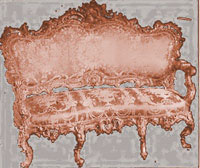Rococo Style and its Balanced Asymmetry
The Rococo style was mainly the creation of J. A. Meissonier. In the beginning, French furniture stylists, especially the supporters of the angular and dry, considered his designs an abomination, because they have broken the straight line in an outrageous manner and pushed the curve to extreme limits.
The distinguishing mark of the Rococo is the lack of precise balance in the use of ornament. However, even with different details on the sides, the style maintains the overall effect of piece balance, as the ornaments were skilfully arranged.
True, unbalanced details were introduced during the Regency, but under the leadership of Meissonnier, the attempts to have the same design on both sides of a given center really disappeared.

A Rococo Canapé
Meissonier began by destroying the straight lines, curved the cornices and made them bulge in all directions. He curved them above and below, gave curves to all, even to the mouldings that seemed least susceptible of them.
He invented contrasts, and completely banished symmetry. No two sides of the panels were alike. On the contrary, the two sides seem to be trying which could deviate most, and most oddly, from the straight line that governed them before the Rococo style.
The Rococo furniture style introduced by Meissonier was in the beginning a balanced arrangement of fanciful shell work, but he soon developed the contrasted balance that is one of the striking features of the style. In this method the shell scrolls seem to be placed without regard to balancing one side with the other. A scroll on the left of a panel will curve upward while that on the right will curve downward, while the middle decoration points to one side or the other. And yet the completed decoration has an effect of balance that is delightful. The secret is that instead of balancing identical details, Meissonier balanced masses.
In defying the laws of balance, one side of a console or cabinet was quite different from the other, but, surprisingly, the sense of harmony was not disturbed.
While Gilles-Marie Oppenord was the leader during the Regency, Meissonier was the master of the Rococo, and prepared the terrain for what will later become the Louis XV style. His rocaille, despite the initial opinions of his contemporaries, evaded the exaggerations of the foreign craftsmen of the time, and kept within the bounds of good taste. It appears that Meissonier’s work also greatly influenced the English Chippendale.
The Rococo was essentially a forced style, a new development was strongly desired, and the new style had to harmonize with the lavish court of France. Despite being an arbitrarily created style, the Rococo is one of the wonders of the art world.
Later in the reign of Louis XV, Briseaux and Blondel introduced more straight furniture lines, creating the long, narrow moulding panels with corners and cornices in Rococo style.
